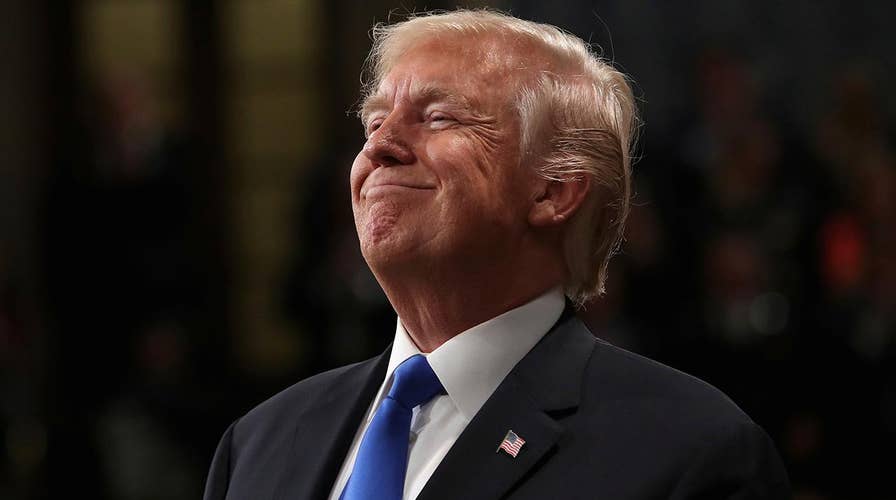White House beaming after Trump's first State of the Union
Kevin Corke recaps the biggest moments from the president's speech.
Democrats wasted no time continuing their nonstop attacks on President Trump after his State of the Union address Tuesday. They insist Donald Trump is the worst president in American history. While President Trump has left himself open to well-deserved criticism, many still don’t understand why he was elected and continues to retain the support of millions of Americans.
Here’s why:
President Trump shows concern for blue-collar Americans. Most Americans don’t have college degrees and big paychecks. They worry about factories and other businesses leaving the U.S. to take advantage of cheap labor abroad, and see products made in foreign lands flooding our country. At the same time, they find 40 million foreign-born adults and their 20 million native-born adult children competing with them for jobs. They fear these trends hold down their wages. Democrats eager for votes and Republicans eager for low-cost labor have turned a blind eye to the concerns of these Americans. Donald Trump became the first Republican presidential candidate in recent years to win the Rust Belt states of Pennsylvania, Ohio, Michigan, and Wisconsin because he acknowledged the concerns of working men and women and promised to be their champion.
Millions of Americans don’t see President Trump’s concerns over immigration as racist. They recognize the Obama administration squandered one of America’s best opportunities to accelerate growth, raise wages, pay for retiring baby boomers, and defend America against its growing adversaries by allowing low-skilled immigration at the expense of high-skilled immigration. They see President Trump as working to protect American jobs; keep out criminals, terrorists and illegal drugs; and strengthen national security. And they see the wall President Trump wants to build along our border with Mexico as a symbol of these common-sense objectives.
Democratic economic policies have been very costly. Despite a deep recession greeting him when he took office, President Obama’s economic policies yielded the slowest economic recovery since World War II. The Obama administration ignored America’s best opportunity for economic growth by failing to issue America’s annual allotment of 1 million green cards to admit the highest-skilled immigrants. Productivity grew at an average rate of 2.5 percent annually over the 18 years prior to Democrats asserting unencumbered control over the federal government in 2009 and 2010. Since then, productivity has grown at an average rate of only 0.7 percent per year – a dramatically slower rate. The Congressional Budget Office estimates that difference cost government nearly $5 trillion of lost tax revenues over 10 years. Is it any wonder that the Dow Jones Industrial Average has risen 45 percent from a cyclical high since Republicans won control of the House, Senate and White House?
President Trump has the courage of his convictions. He doesn’t bow to political correctness and conventional wisdom and stands up for America. He supported GOP Senate candidate Roy Moore in Alabama to strengthen Republican control of the Senate, despite well-deserved criticism of Moore’s alleged sexual misconduct. He’ll criticize anyone who opposes his vision to Make America Great Again – Democrats, Republicans and the media.
President Trump is working to project strength around the globe. He is rebuilding our military. He broke the back of ISIS and drove it out of its strongholds by hitting the terrorists harder than President Obama ever did. He recognized Jerusalem as Israel’s capital, threatened to renegotiate the Iran nuclear deal, stood up to North Korea’s dictator Kim Jong Un and has insisted on renegotiating America’s trade pacts.
The president speaks directly and clearly to the American people. Through his use of Twitter and candid and colorful comments to the media, President Trump commands public attention like no other president. He fills TV newscasts and stories on the web, radio and print. Supporters and opponents talk about him every day. Perhaps the president should pick his fights and choose his words more carefully, but he has shown that the notion that a president shouldn’t speak directly, succinctly and frequently to the world is preposterous.
Still, uncertainties lie ahead for President Trump. What will come of Special Counsel Robert Mueller’s investigation of Russian meddling in the 2016 presidential election? Will Democrats succeed in portraying President Trump as being too friendly to Russia? Will Democrats capture control of one or both houses of Congress in the November elections and use their control to block the president’s legislative initiatives and possibly move against him with impeachment proceedings?
With unemployment down to 4.1 percent in December, wages beginning to rise, lower taxes, the gross domestic product growing faster than it has in the last eight years and the stock market reaching record highs, one might expect President Trump to be more popular outside his base.
But traditionally, a president who aggressively divides America, as President Trump has done, does not fare well with the American people in opinion polls and when he seeks re-election. As he begins his second year in office, President Trump should remember that, while identity politics dividing America won him votes in 2016, if he wants to broaden his base he will also need to reach out and show he respects other points of view and help heal the wounds dividing our nation.

